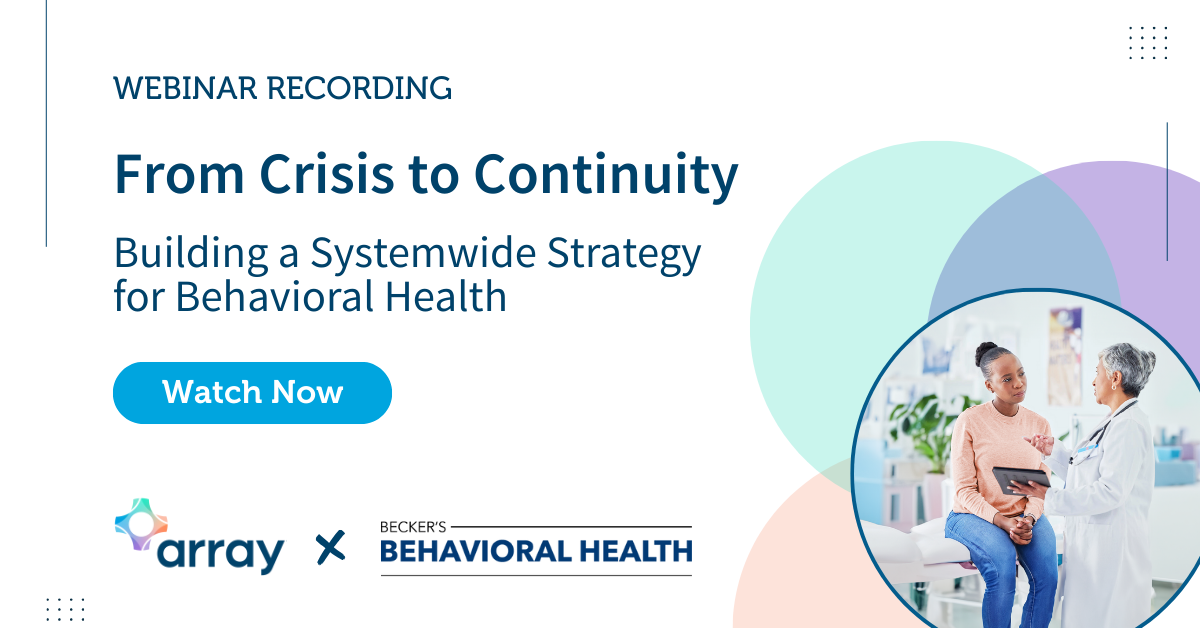Summary
- Arbor Place faced challenges in hiring and retaining therapists for substance use treatment – which resulted in care delays and gaps in care. Communication inconsistencies between inpatient and outpatient clinicians and staff sometimes exacerbated the issue.
- Through a strategic partnership with Array, staff and patients at Arbor Place now have reliably consistent access to virtual care and consultation from an expert who specializes in co-occurring mental health and substance use treatment.
- As a result, patients benefit from consistent, high-quality specialty care through holistic approaches. Arbor Place has achieved enhanced organizational efficiency and improved patient outcomes.
- The collaboration with Array shows the value of effective telehealth services to improving access to specialty care, breaking down health system silos, and providing effective pathways to treat co-occurring conditions.
Partner profile
Arbor Place, a non-profit treatment center in western Wisconsin in operation for 50 years, provides prevention, treatment, and recovery services to individuals with substance use and mental health disorders. They offer residential, day, and outpatient treatment, prevention services, family support and education. Arbor Place serves the Eau Claire, Menomonie, and River Falls areas.
The counties within which Arbor Place operates face starkly low levels of access to mental healthcare specialists. Dunn County has a ratio of one mental health provider per 480 people. Pierce County has nearly ten times the ratio of population at 1,420 people per mental health provider.
Wisconsin faces a prevalence of substance use disorder (7.7%) that is similar to the national average (7.4%). According to a 2020 report from the Substance Abuse and Mental Health Services Administration (SAMHSA), “in a single-day count in March 2019, 25,574 people in Wisconsin were enrolled in substance use treatment – an increase from 24,371 people in 2015.” Drug overdose death rates have increased statewide, from 12.1 per 100,000 in 2011 to 31.6 per 100,000 in 2021.
A 2023 report from Mental Health America found that 15.35% of adults reported having a substance use disorder in the past year. Of those, a grand majority did not access treatment (93.5%).
Challenges
- Hiring and retaining master’s degree level therapists for long-term work with substance use and recovery patients due to burnout and difficulty attracting candidates to rural areas.
- Maintaining clear, formalized forms of communication across Arbor Place care staff, especially between residential and outpatient settings, to prevent gaps in understanding of patient history and treatment plans.
- Creating continuity of care to enhance patient motivation and consistency along the treatment pathway.
Arbor Place faced difficulties in hiring a master’s degree level therapist to work over the long term with patients in the challenging substance use and recovery space. Retention had been difficult due to burnout and limited ability to attract candidates to more rural areas.
The varied patient journeys through substance use treatment programs could lead to inconsistencies in care. With Arbor Place’s patients often shifting between residential and outpatient settings, sporadic or informal communications between team members could lead to gaps in understanding. Staff at times lacked the full history and treatment plan for an individual, such as someone being discharged to outpatient care and seeking support in their community.
For Arbor Place’s patient population, consistency and continuity are essential to maintaining patient motivation. “Clients aren’t coming to us for short-term services but investing a significant amount of time for working on themselves, their healing from substance use, and their mental health. When they must retell their stories – which can deal with difficult or traumatic parts of their lives – they may be less likely to stay the course or return for treatment,” said Jill Gamez, Executive Director, Arbor Place.
Research supports that better rapport and relationship-building between psychiatrists and their patients leads to improved outcomes.
Solution
- Array matched Arbor Place with a highly qualified therapist experienced in substance use treatment, allowing the organization to provide the level of service they were aiming for.
- The partnership has improved service consistency across inpatient and outpatient settings, built better rapport with patients, and enhanced communication and information sharing among treating providers.
- The holistic link between substance use programs and mental health care through telehealth services has provided an effective model for treating co-occurring conditions.
Array thoughtfully matched Arbor Place with a highly qualified clinician with previous experience treating patient populations affected by substance use, including within primary healthcare settings. Sonja McQuiston, a full-time licensed professional counselor and licensed mental health therapist for Array, provides care across Arbor Place’s service delivery models via telehealth.
Prior to joining Array, McQuiston worked independently and collaboratively with physicians to provide individual therapy services to diagnose, educate, and advocate for patients at Women’s Health Services in Tennessee. Her past experiences also include collaborating with correctional officers, police personnel, family care services teams, and the Cookeville Department of Children’s Services in Tennessee to assess varying mental and behavioral health needs of patients in those communities.
So far, McQuiston has provided over 3,000 hours of clinical service and been one of the longest tenured therapists at Arbor Place.
McQuiston is included in staff meetings and regularly connects with outpatient and residential clinicians to share and receive case updates. “If there is a case that concerns me as a clinician, I staff it with the clinical team for additional support and guidance. As a team, we identify viable solutions, allowing everybody to be on the same page in terms of care alignment,” said McQuiston.
Gamez says this collaboration and consistency creates better overall care for Arbor Place’s patients who often transition between varying levels of care and require dependable, long-term supports: “As leaders in our organization and in the mental health space, it’s impactful to thoughtfully consider our patient experience and how it can be improved – not just within the walls of our facility but also beyond. There are so many aspects of the mental health system that are siloed and segmented. We are grateful for solutions like Array that generate more consistency in care for our clients,” added Gamez.
Benefits of a strategic, consultative partnership between Array and Arbor Place:
Enhanced patient safety and well-being
Patients can feel abandoned when they need to switch care providers and having to retell their story can create stress or trigger previous trauma. Patients at Arbor Place can now access reliable and compassionate mental healthcare within their communities through telehealth with Array. Their mental wellness is addressed in an ongoing, consistent, and proactive way.
Continuity of care across settings
Through telehealth, patients can easily and conveniently be seen by the Array clinician across health settings – from residential to outpatient. This continuity of care bridges substance use recovery and mental health supports in a holistic approach to treating co-occurring conditions.
A focus on continual improvement and measurements-based care
Arbor Place assesses mental health outcomes using a standardized screening tool for all patients. As a consultative and collaborative partner, Array aligns and interfaces with Arbor Place’s existing tools and processes – while identifying further opportunities for improvement in clinical and operational efficiency.




